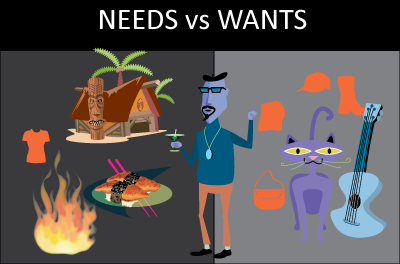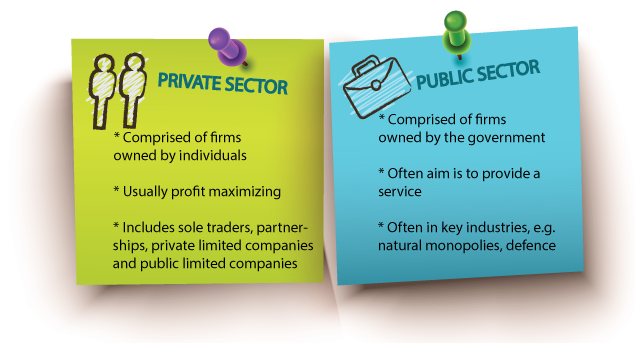Needs vs Wants
Needs are things that are essential to human survival. These are:
- Warmth
- Shelter
- Clothing
- Food and Water
Wants are things that are desired but are not essential for human survival.
The basic economic problem is that our needs and wants are infinite but our resources are scarce

Scarcity and Choice
Scarcity refers to the fact that things are limited or finite in nature. If you drink a coca-cola, it is used up, you cannot drink that same cola again. Similarly, if you decide to use some coal to fire a power station, you cannot use that same coal again.
Because resources are scarce we have to make choices about what to produce. This is known as resource allocation. As individuals we make choices according to what gives us the greatest satisfaction. As firms, we decide what to produce according to what gives us the greatest profit.
Resources are therefore allocated according to what is most profitable, which in turn relies on consumers feeling satisfied by this product.
We can illustrate these choices on a Production Possibility Curve (image - right)- this shows us all the different combinations our resources can be allocated in. If we just produce carrots, we produce no potatoes, and vice versa.

Opportunity Cost
Opportunity cost is the value of the next best alternative given up when a decision is made. Because resources are scarce we have to make choices over what to produce - we cannot turn a lump of iron into both a chair AND a toy race car, we have to decide between them.
Because we are profit maximizers, we allocate resources according to what is most profitable. If we are set to make $50m from choosing to make chairs rather than $40m from toy race cars, we go for the chairs. Our opportunity cost is therefore $40m; we gave up the possibility of making $40m in order to make $50m. Every choice a firm takes has an opportunity cost.
The Role of Specialisation
Specialisation is the process of increasing efficiency by becoming a master of a specific area. Because resources are scarce, it is vital that we waste as little as possible when producing. By wasting little, we can produce more, and therefore earn greater profits. s
Specialisation allows for greater productivity. It can be achieved through
- Training and Education - when workers are trained to know exactly how to get the most out of the resources at hand. e.g. a specialist carpenter will know exactly how to cut a block of wood so as to have little leftover
- Division of Labour - when workers are split up in order to tackle one part of a process. They therefore become very used to their part (e.g. creating glazing for a cake) and so can do it quickly, without wasting time going between jobs.
- Mechanisation - This is the process of replacing humans with machinary. Machinary can often be more efficient than human labour as they don't take breaks or require any rights.
Advantages / Disadvantages of Specialisation
+ Allows for a lot more to be produced
+ Average costs fall
+ Production speeds up
+ Allows for automation (easy for machines to do one part of a job)
- It can be monotonous and boring for the worker
- Machines may replace workers
-
Training and education are required at the beginning
Industrial Classifications

In any country, we can catagorize production into three or four main industries:
- PRIMARY SECTOR- these are the firms that draw or extract natural resources from the earth. This may be as varied as coal mining or fishing, corn growing or oil drilling.
- SECONDARY SECTOR - these are the firms involved in turning natural resources into finished products. This may vary from car production to packaging. They manufacture the goods.
- TERTIARY SECTOR- firms in this sector provide the retail outlet for the finished products or provide a service for the customer. This may range from shops on the high street to teaching
- QUATENARY SECTOR- firms in this sector are usually involved in intangible services such as research and development
Why are classifications important?
Look at the pie chart to the right. It shows the percentages of the value of output produced in an economy by sector
1) If the primary sector were to decrease, how might this be evidence of development?
2) Is there a relationship between the size of a sector and the level of employment in that sector?
3) In which sector would you find the most value-added products?

Economic Classifications
Economic Sectors can be split into two areas; the public and the private.
In a command economy, the government owns all the resources of a country, so only the public sector exists, not the privat
In a free market economy, there is no government, and all resources are owned by individuals in the private sector.
Most economies are a mix of both sectors and are therefore known as mixed economies
Importance of Economic Classifications:
- Helps to show development
- Can be used to show employment areas
- Can be used by governments to decide future economic policy
Look at the pie chart to the right, which shows economic sectors by output:
- Do you think this country is developed or developing? Why?
- Why does the pie chart not neccessarily tell us much about employment?
- Which sector do you think is most capital intensive and which is most labour intensive?



Successful Entrepreneurs
Characteristics of successful entrepreneurs are of particular interest to people with businesses.
Read the following article and answer the questions below:
http://www.bbc.co.uk/news/business-33068445
1) Using examples from the article, give three characteristics you would use to describe Mr Altrad
2) Use an example to show how Mr Altrad responded to adversity
3) What do you think motivates Mr Altrad? Use a quote from the text to prove your point
4) How do you think Mr Altrad's experiences helped shape him for the world of business? Use quotations from the text to explain your answer.
What is a business plan?
This is a document that records a wide variety of information neccessary to the new entrepreneur. It will include information on:
a) The nature of the product
b) The market
c)
The competition
d) Finances
Why are business plans important?
- For accountability
- For measuring success
- To see if the business will succeed
- To bring in finance from banks

How government's help start-ups and SMEs
An SME is a small or medium enterprise. These are often known as start-ups when they are first set up. The government often helps them through
- Grants - these are gifts of money given to a company
- Subsidies - these are gifts of money made per unit of output. So if a firm produces 100 units and there is a subsidy of $10 per unit, then they will earn $1000 in total. Many wind farms (right) received subsides recently.
- Advice and Training- governments can advise on matters such as tax or where to setup
- Provision of Infrastructure - if a government builds good transport links or communications systems, firms may be encouraged to set up there.
Why do governments help start-ups?
- To boost employment -
- To boost regional employment
- To improve taxes
- To boost the production of certain goods
- To improve international competitiveness
- To improve competition


Measuring Business Size
How to measure business size:
- Value of output (revenue) - this is done by finding out how many goods a company has sold, and multiplying it by the price they sold them at. e.g. 100 goods x $15 = $150
- Market Share - this is done by dividing the total value of a firm's output by the total industry output and multiplying by 100. e.g. if a firm's output was $150 but the industry was $1500, we would do: ($150/$1500) x 100 = 10%. Alternatively, can be done through volume of sales (as in the graph, which shows % of output).
- Employment - this is simply recording who has the greatest number of employees, as shown in the graph to the right.
- Capital Employed - this is finding out which company has the most valuable assets used in production - remember, capital can be used to refer to goods that make other goods.
Each of the above measurements, however, will give different companies different sizes.


Business Growth
How businesses can grow
- Internally
- Through use of profits
- Through issuing shares
- Externally
- Integration
- Takeover / Acquisition
- Merger
- Integration
Types of Integration
- Horizontal - when firms in the same stage of production join together e.g. chocolate factory merges with crisp factory
- Vertical forward - when a firm in one stage of production joins with another in the stage of production after it. e.g. chocolate factory buys chocolate shop.
- Vertical backward- when a firm in one stage of production joins with another in the stage of production before it. e.g. chocolate factory buys cocoa plantation.
- Lateral / Conglomerate - firms in unrelated sectors of production merge. e.g. crisp factory buys a gold mine.
Benefits of Integration


Type of Business Organisations
| Form | Features | Advantage | Disadvantage |
| Sole Trader |
|
|
|
Paternership
|
|
|
|
| Private Limited |
|
|
|
| Public Limited |
|
|
|
| Joint Venture |
|
|
|
Incorporated vs Unincorporated

Franchises
This is when an established company (usually a multinational) provides an entrepreneur with the right to sell the established company's products. The franchisor (the established company) provides a lot of the materials needed for doign so, such as packaging, design, prices and advice, and the franchisee (the new company) then sells these products for the franchisor. In return, the franchisee pays a royalty back to the partent company - this is usually a % of the profits earned.
Many large companies run franchises, such as McDonalds, Burger King, Starbucks and Costa Coffee.

Public Sector Organisations
We can identify two different public sector organisations:
- Public Corporations
- Run by the government for the benefit of the people
- Targets set by government
- Legally separate entity from government
- Run by directors, appointed by government
- e.g. BBC (British Broadcastering Corporation)
- Paid for through taxes
- Local Authority Institutions
- Run by a region or local authority for the benefit of the people
- Can be subsidized or profit-making
- Offer services for needs of the area - e.g. swimming pools
Read the following article:
http://www.bbc.co.uk/news/entertainment-arts-33519385
Differing Business Objectives
Read the following article and then answer the questions:
http://www.bbc.co.uk/news/technology-33534256
1) What have Amazon's profits traditionally been like?
2) Using figures, explain what objective has Amazon put before profit?
3) How is it possible for one firm to have lower revenues and higher profits than another?
4) What does Amazon do with a lot of the profit it generates?
5) Give some examples of innovations that may not yet be profitable that Amazon has created.
6) How much revenue did Amazon make in 2015?

How objectives change

Social Enterprises
These are companies that do not necessarily have profit as their main objective. Instead they may aim to have a variety of social or ethical aims such as:
- Improving living standards
- Highlighting unethical practices or concerns
- Protecting environmental areas

Stakeholders & Stakeholder Conflict
Stakeholders are groups or individuals that have an interest in the success of a business. All stakeholders want the company to succeed but may also have other objectives.
Internal stakeholders are those that can be found within the company. They include:
- Employees
- Managers
- Owners
- Shareholders
External stakeholders are those that are found outside of the company. They include:
- Government
- Local Community
- Suppliers
- Creditors
Stakeholder Conflict ocurs when two or more stakeholders groups want things that are opposed to one another. Fill in the table below outlinging how the groups may conflict. Examples may include the local community being upset about a manager's decision to lay off workers in order to make more profit.
| Government | Local Community | Suppliers | |
Employer
|
|||
Managers
|
|||
Shareholders
|
|||
Owners
|












